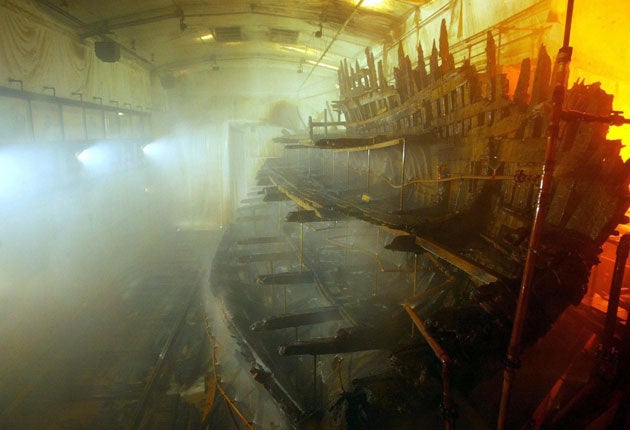Museum to show Mary Rose sailors' remains
Human bones and Tudor artefacts are to go on display for the first time

More than 450 years after they drowned in a battle with a French invasion force, the remains of 90 crew members of the Mary Rose warship are to be put on public display.
Alexandra Hildred, a curator at the the Mary Rose Museum in Portsmouth, said discussions are underway to mount a major exhibition in which objects found on the ship will be showcased next to their original owners.
On 19 July 1545, the Mary Rose, the flagship of Vice-Admiral Sir George Carew, set out from Portsmouth, along with some 80 other English vessels, to confront a fleet of 225 ships, carrying 30,000 soldiers, sent by King Francis I of France to attempt an invasion.
She sank with the loss of more than 400 lives, in circumstances which remain unclear to this day. A dismayed King Henry VIII watched the battle from onshore, in Southsea Castle.
The underwater wreck was discovered in 1836 by a fisherman in the Solent. It became an officially protected site in 1974, and was excavated in 1982. Only 1,000 objects have so far been seen by the public, from a stock of 19,000 underwater finds. This is about to change, at the renovated museum in Portmouth's Historic Dockyard zone.
The project is due to be completed by 2010, depending on a further £4m of funding being secured. "We are discussing the possibility of displaying human remains next to the objects," Ms Hildred said. Another option is to have the human remains in a separate area, to be viewed by appointment only.
None of the remains have been seen before, except for two skulls shown earlier this year. "Displaying bones is something that causes huge controversy," Ms Hildred acknowledged. "We have not yet decided how we will do it."
The previously unseen relics include Europe's oldest fiddle and bow, a beautifully preserved leather "man bag" (the height of Tudor fashion), a giant wooden spoon used to stir the crew's porridge pot, arrows, longbows and backgammon boards.
Rear Admiral John Lippiett, chief executive of the Mary Rose Trust, said: "The importance of these Tudor artefacts, many of which we have never had the space to put on public display, cannot be over-estimated. Nowhere else is a single moment in Tudor life captured as it is with the Mary Rose."
An anatomical curiosity, the os acromiale, is common in skeletons recovered from the Mary Rose. It is a separate, unfused shoulder bone thought to result from heavy archery practice from childhood. The late medieval war bow required such a strong pull that it prevented fusing of the bone. The museum project has already received £21m of heritage lottery funding and has raised £14m, but needs £4m to complete the project.
Historical explanations for the loss of the Mary Rose include any combination of: unfavourable winds; an incompetent crew; a strike from a French cannon ball (later masked by political spin); or her top-heavy load as she carried 185 armour-clad soldiers on her upper decks. Only 35 men survived.
See www.maryrose500.org for more information on the fundraising project
Subscribe to Independent Premium to bookmark this article
Want to bookmark your favourite articles and stories to read or reference later? Start your Independent Premium subscription today.

Join our commenting forum
Join thought-provoking conversations, follow other Independent readers and see their replies